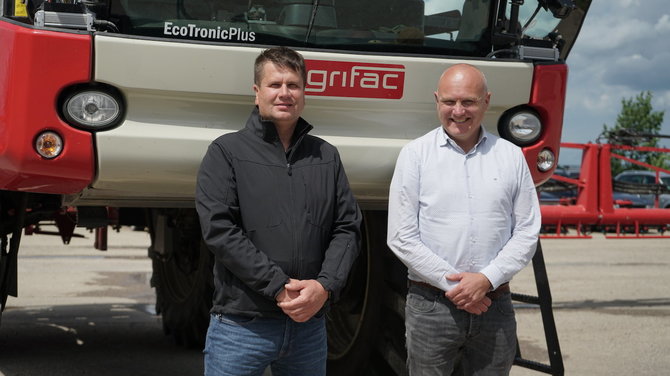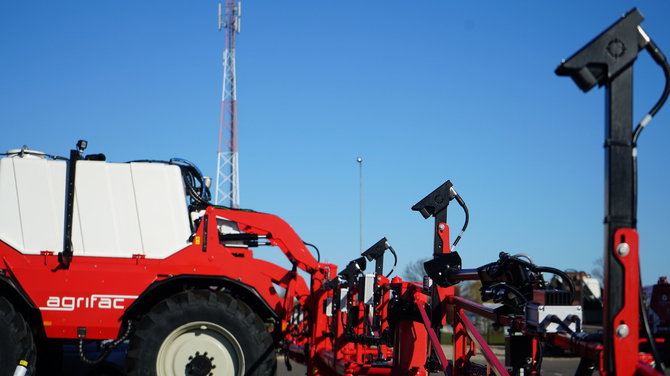This allows for comprehensive resource savings, such as reduced quantities of sprayed chemicals and water, farm maintenance costs and reduced need for manual labour during the season.
Innovative systems save chemicals and time
The video camera system AiCPlus has been installed on a self-propelled Agrifac sprayer and records the field and plants in it. This information is immediately processed and allows farmers to spray their fields by two methods: either ‘green on brown’ or ‘green on green’.
With the first method, exterminating weeds in a brownfield, the spraying system adapts varying chemical doses for various plants, and it only sprays what is green. Camera sprayers of this type have already been successfully adopted in other countries around the world. For example, in Australia, where fields are left untouched almost half a year after harvesting, such spraying allows for chemicals savings of up to 90 per cent and respective quantities of water.
“For major Australian farms, which cultivate tens of thousands of hectares, just this is enough to speed up the sprayer’s pay-off. The situation is a little different in Europe, but here too, the economies will be notable,” Algimantas Gyvis, a specialist at Dotnuva Baltic, which represents Agrifac self-propelled sprayers. He notes that such technologies allow major farms to resolve challenges and reduce costs.
The second method of spraying – ‘green on green’ – is a novelty on the market. It offers opportunities to only spray specific types of plant, typically weeds, while traversing a green field. The manufacturer has created special algorithms for this, which help the cameras recognise specific weeds and immediately relay the information to a computer. This way, the chemicals are sprayed exactly where necessary. While driving through a field, it is possible to exterminate one type of weed at a time.
“The reduction of chemical use in agriculture is no longer a future challenge – it is a reality the entire world faces right now,” Agrifac sales head for Europe Arnoud de Boer says, “Our task as innovative manufacturers is to manufacture sprayers that would reduce the quantity of chemicals sprayed into fields, ones that would spray only as much as needed per plant, which would conserve the soil and would help farms cultivate the largest harvests possible. The possibility to conserve labour and cultivate the land only to a minimal extent are the needs we must also consider while creating new spraying technologies.”

Spraying algorithm based on the needs of a Latvian farm
Europe’s first self-propelled sprayer of this type, which was manufactured by Agrifac, officially began working in a large Latvian farm from June this year. This is also where the ‘green on brown’ spraying system was first employed and immediately yielded results – spraying weeds in empty plots of land led to a 50 per cent reduction in pesticide use. With there being a small number of weeds in the field, the entirety of it is sprayed with the smallest norm of glyphosates. The spraying system automatically increases the norm in only locations where it observes larger weeds growing.
Other than regular cultures, the aforementioned Latvian farm also cultivates over 600 hectares of clovers for pasture seeds. Seed material must adhere to especially high requirements, and the seeds cannot contain remnants of certain weeds. Thus, farms require a solution allowing to eliminate a single type of weed – sorrels. Up to now, sorrels have been weeded out from the fields by hand, which sees the farm hiring 10-15 staff a year for solely this purpose.
In order to resolve this challenge, technology developers at Agrifac have been developing an individual ‘green on green’ technology for the farm’s needs. Currently, visual information is being assembled on the specific species of sorrel growing in the field. When this is completed, an individual algorithm will be created to allow the sprayer’s cameras to operate effectively. For the algorithm to work, factors such as the plant’s shape, the contours of its leaves and its colour are crucial, and the manufacturer has already been sent more than 80 thousand video files recorded by the sprayer’s camera in the field. By next season, the sprayer camera system AiCPlus, being adapted to spraying individual sorrels, will be carefully tested and will begin practical operation in the farm next spring.
“This is important news for the Baltic States’ markets – this is where the most advanced technologies are being implemented and tested,” Arnoud de Boer notes, “It is natural that a farm cultivating thousands of hectares of land has spoken up about the need for innovative spraying technologies of this level. The economic benefits of a modern self-propelled sprayer are quickly felt by large farms.”
Half of the self-propelled sprayers to have camera systems in five years
Agrifac’s factory in the Netherlands, which was modernised two years ago, manufactures 200 self-propelled sprayers every year and over the coming five years, it is planned to more than double manufacturing. It is believed that in a few years at least half of self-propelled sprayers will have smart cameras.
Furthermore, as of late, among precision farming systems, the agricultural sector has also seen increased popularity in crop data recording by drones and via satellites. These technologies, however, also rely on weather conditions. Agrifac representatives predict that the largest demand in the future will be for camera systems and individual farming technologies, and the manufacturer intends to focus its investment on these areas for the coming future.
The Agrifac factory, which creates solutions for farmers, adheres to sustainability principles and seeks to reduce its environmental footprint. The factory has reached an 97.3 per cent based on the BREEAM (Building Research Establishment Environmental Assessment Method). This is the highest evaluation in the Netherlands and one of the highest in the world. It has been calculated that over the year 2019, the solar modules on the building’s roof have produced more energy than the Agrifac factory itself has consumed. Rainwater collected in a separate 50 cubic metre container is used for testing self-propelled sprayers and for washing the building’s toilets. The building uses very little energy, processes within it are interlinked and its airtightness indicator is at qv-10 0.24. Meanwhile, a more than 500 square metre greenery has been created next to the factory.













